In most Japanese homes, you can find a covering and flooring called tatami [畳]. It is a floor made of rice straw, used for a long time among the Japanese. What are your advantages? Why do the Japanese use it?
In this article, we will see the history of tatami, its origin, where it is usually used, what it is used for, how it is maintained, measures and many other curiosities to solve all your doubts about this traditional Japanese floor.
Índice de Conteúdo
How are the mats?
Tatami is made from a rice straw material, and has been used since the Muromachi Period. At the time, the floor was even considered a luxury item. This floor can be found in many traditional rooms called washitsu (和室).
, tatami is the floor used for training in a dojo and for competing. It is also indicated for the correction of the spine, by masseurs and doctors in general; in the decoration in Oriental style; in the practice of yoga, meditation, relaxation and anti-stress treatments.
Read also: The 10 Japanese martial arts + list
The mats are covered with igusa [藺草] reed straw. The core is traditionally made from rice straw, but contemporary ones sometimes have compressed wood boards or polystyrene foam cores.
The long sides can be embroidered in hero [縁] with brocade or plain fabric. The tatami is composed of 3 parts known as doko (interior), omote (surface) and fuchi (edge).
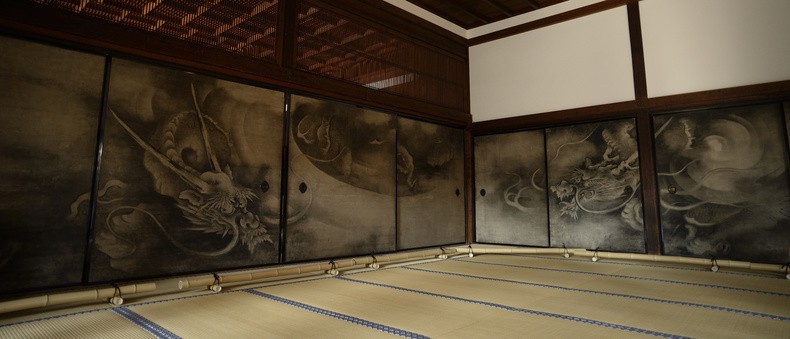
How big is a mat?
Tatami mats are made in standard sizes, twice as long as they are wide and can change depending on the region. A standard tatami is 90cm x 180cm and 5cm thick.
The tatami have become so common in Japan that they are used as a measurement for rooms. Many Japanese people, instead of using square meters, talk about the number of tatami mats in a room to better understand its size.
Além do padrão, existe uma meia esteira chamada de hanjō [半畳] e uma esteira de três quartos de comprimento, que é usada em salas de cerimônia do chá, chamada daimedatami [大目].
We recommend reading: Chanoyu – Japanese tea ceremony
The size of the mat traditionally differs between regions in Japan:
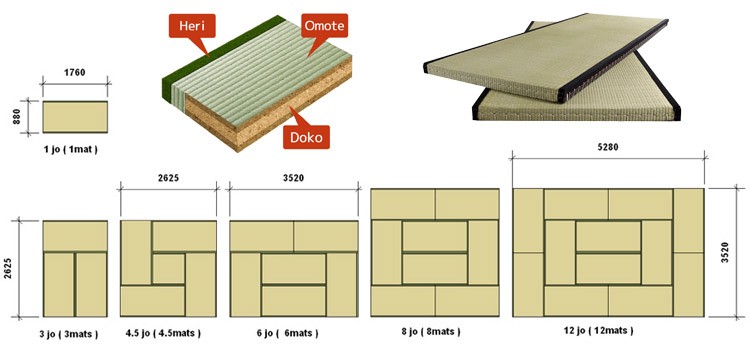
What does tatami mean?
In the West, tatami is widely used to refer to floors and pieces of EVA for children or used in gyms and fight rings. The Japanese tatami made of straw can be more easily found in stores and on the internet if it is written with [i].
In fact, the tatami floors used in fighting and martial arts are also known by the name of shiai-jo. In a dictionary of the Portuguese language, we also find another transliteration that is tatâmi.
Na verdade, o termo tatami é derivado do verbo tatamu [畳む], que significa "dobrar" ou "empilhar". Isso indica que os primeiros tatames eram finos e podiam ser dobrados quando não usados ou empilhados em camadas.
Antigamente tatami era uma palavra usada para referir-se a qualquer piso dobrável como goza e komo. Seu ideograma [畳] é composto dos kanji arroz, olho, mesa e piso. A forma que os tatmes são colocados em um quarto também recebe nomes diferentes.
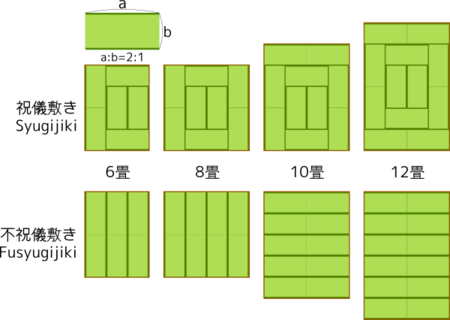
The article is still halfway through, but we recommend also reading:
History and Origin of Tatami
Já no período Kamakura (1185-1333) foi introduzido um revestimento de palha de arroz chamado shoindukuri. Esse revestimento era luxo e costumava ser encontrado nas casas de chá ou das realeza, o resto da população vivia em casas com chão batido.
It was only in the Edo period that most houses in Japan had access to this floor. During the Heian period, the shinden-zukuri aristocratic residences still had a wooden floor, the tatami mats were only used as seats for the aristocrats.
No período Kamakura os pisos tatame começaram a espalhar gradualmente para salas inteiras. As salas totalmente cobertas com o piso passaram a se chamar zashiki [座敷]. Logo essas salas de sentar tiveram suas regras e etiquetas.
Em meados do século 16, a nobreza governante e os samurais dormiam em tatames ou tapetes de tecidos chamados goza [茣蓙], enquanto os plebeus usavam tapetes de palha ou palha solta para a cama. Os tatami foram gradualmente popularizados e alcançaram as casas dos plebeus no final do século 17.
Currently, tatami mats are not usually filled only with pressed rice straw. Today, more resistant materials such as wood pulp, polystyrene, or particle boards are used. The surface is made up of a web of bamboo or reed, while its edge is made of fabric and serves as a decorative finish.
We also recommend reading: Kadomatsu - Japanese bamboo decoration
As casas construídas no Japão hoje costumam ter poucos cômodos com piso de tatami, isso se tiver. Os quartos com piso de tatame e outras características arquitetônicas tradicionais são referidos como nihonma ou washitsu, "quartos de estilo japonês".
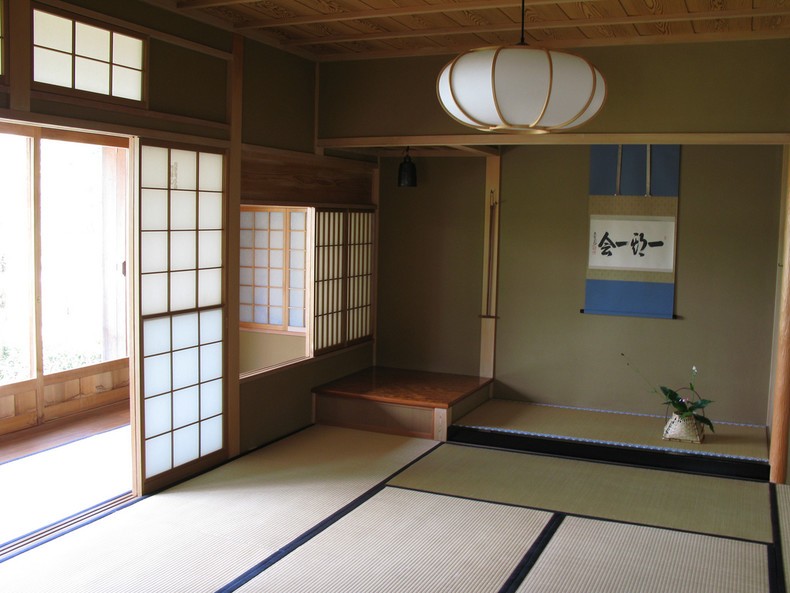
types of tatami
In addition to referring to the traditional flooring of Japanese homes, the word can also indicate other different types of flooring. As mentioned, any type of folding floor can be called a tatami.
No ocidente os tatames são mais conhecidos como a arena de artes marciais como karatê e judo. Esses pisos são chamados de Judo Tatami (柔道畳) e são mais resistentes e possuem um tamanho diferente, sendo feitos de uma maneira diferente.
Caso seu quarto seja no estilo ocidental, existem pisos chamados de Yunitto tatami (ユニット畳) e Oki Tatami (置き畳) que podem ser colocados como tapete nos quartos. Enquanto um piso de palha de arroz novo é da cor esverdeada, ao passar do tempo ele começa a ficar amarelado.
There will come a time when it's necessary to replace the tatami mats and take the old ones to be recycled. If you take good care of them, they can last up to 6 years. Currently, the tatami mats are made in factories, while in the past they were made manually by hand.
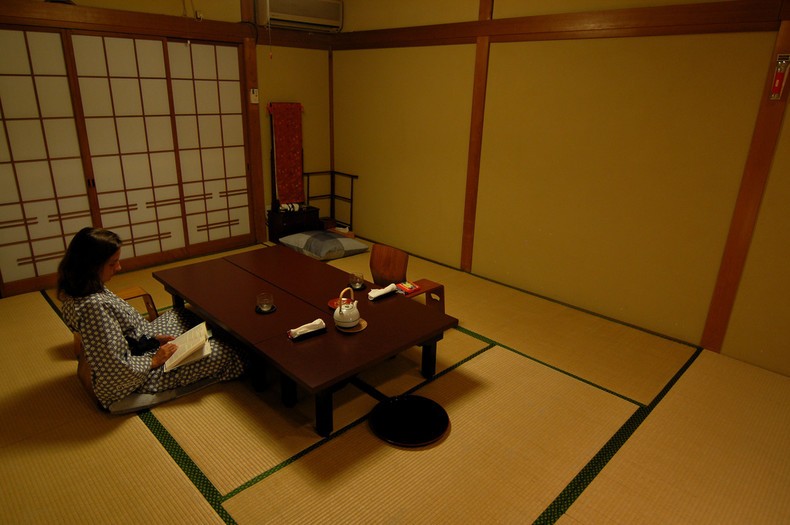
Labels and care for tatami floors
It is not allowed to step on the tatami with shoes, not even with suripas (slippers). It is not common to place chairs on this type of floor, they usually sit on the floor or on cushions called zabuton.
In most rooms with this type of flooring, you will find a sliding door. Be careful not to step on the tracks (shikii), as this is considered rude and can cause damage. Also, try to avoid stepping on the edges of the flooring to prevent wear and tear. In rooms with tatami, you should sleep using the famous futon. futons, you should choose furniture and objects that will fit well with the kotatsu.
You should not pour water on a tatami-covered floor, cleaning is usually done with vacuum cleaners or a damp cloth. These rice straw floors tend to attract many dust mites, for which there are products developed to prevent dust mites. What do you think of this floor? Leave your opinion and tips in the comments.
Read also:
Where to buy a mat?
Finding EVA tatami flooring is easy, but finding traditional flooring is tricky. You will also easily find meditation pillows with rice straw bottoms.
You can buy a Japanese mat at specialty oriental stores, sporting goods stores, or online. Here are some options you can look for:
- Specialty brick-and-mortar stores: Check to see if there are Japanese or Oriental stores in your area. These stores may sell Japanese mats or direct you to places where they can be purchased.
- Sporting Goods Stores: Some stores that sell sporting goods, especially those that focus on martial arts and practices like judo, aikido, and karate, may offer Japanese mats for sale.
- E-commerce: There are a wide variety of online options where you can find Japanese mats. Some popular platforms include Amazon, eBay, Walmart, among others. Be sure to read product descriptions, customer reviews, and verify measurements, materials, and seller's reputation before making your purchase.
- Specialty Japanese Stores: There are online stores specializing in Japanese goods that may offer authentic Japanese mats. Search for these stores and see if they have options available.
Remember to consider the size, material and quality of the mat when making your selection. Also check if the store offers delivery or shipping options for your region.







